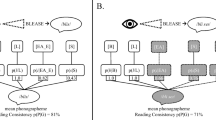Summary
A series of experiments are reported concerning the regularity effect in single- word pronunciation and lexical decision tasks. Experiment 1 compared pronunciation latencies for exception words based on unfamiliar letter patterns (e.g., YACHT) with exception words based on common letter patterns (e.g., PINT). It was found that both types of exceptions produced longer latencies than regular words. Experiment 2 employed a more objective basis for matching exception and regular words for letter pattern familiarity. Under these conditions exception words still produced significantly longer pronunciation latencies than regular words. These experiments show that previous demonstrations of the regularity effect in pronunciation cannot be attributed to uncontrolled visual differences between exception and regular words. Experiment 3 investigated whether the same material as Experiment 2 would produce a regularity effect in lexical decision but this was not found. Theoretical implications of these resuts and discrepancies with previous studies are discussed.
Similar content being viewed by others
References
Baron, J., & Strawson, C. (1976). Use of orthographic and word-specific knowledge in reading words aloud. Journal of Experimental Psychology: Human Perception and Performance, 2, 386–393.
Bauer, D.W., & Standovich, K.E. (1980) Lexical access and the spelling-to-sound regularity effect. Memory & Cognition, 8, 424–432.
Carroll, J.B., Davies, P., & Richman, B. (1971). The American Heritage Word Frequency Book. Boston: Houghton-Mifflin.
Clark, H.H. (1973). The language-as-a-fixed-effect fallacy: A critique of language statistics in psychological research. Journal Verbal Learning and Verbal Behavior, 12, 335–359.
Coltheart, M. (1978). Lexical access in simple reading tasks. In G. Underwood (Ed.) Strategies of human information processing. London: Academic Press.
Glushko, R. (1979). The organisation and activation of orthographic knowledge in reading alound. Journal of Experimental Psychology: Human Perception and Performance, 5, 674–691.
Gordon, B., & Caramazza, A. (1982). Lexical decision for open- and closed-class words: Failure to replicate differential frequency sensitivity. Brain & Language, 143–160.
Henderson, L. (1984). Issues in the modelling of pronunciation assembly in normal individuals. In J.C. Marshall, M. Coltheart and K. Patterson, (Eds.) Surface Dyslexia and Surface Dysgraphia. London: LEA.
Humphreys, G.W., & Evett, L. (1985). Are there independent lexical and nonlexical routes in word processing? A evaluation of the dual route theory of reading. The Behavioral and Brain Sciences. 8 689–739
Kay, J, & Marcel, A. (1981). One process, not two, in reading words aloud: Lexical analogies do the work of non-lexical rules. Quarterly Journal of Experimental Psychology, 33A, 397–413.
Kucera, H. & Francis W.N. (1967). Computational Analysis of Present-Day American English. Providence, R.I.: Brown University Press.
McClelland, J.L., & Rumelhardt, D.E. (1981). An interactive activation model of context effects in letter perception; Part 1. An account of basic findings. Psychological Review, 88, 375–407.
McClelland, J.L., & Rumelhardt, D.E. (1982). An interactive activation model of context effects in letter perception: Part 2. The contextual enhancement effect and some tests and extensions of the model. Psychological Review, 89, 60–94.
Norris, D & Brown, G. (1985). Race models and analogy theories: A dead heat? Reply to Seidenberg. Cognition, 2u, 155–168.
Pachella, R.G. (1984). The interpretation of reaction time in information processing research. In B. Kantowitz (Ed.), Human information processing: Tutorials in performance and cognition. Potomac, MD: Erlbaum.
Parkin, A.J. (1982). Phonological recording in lexical decision: Effects of spelling-to-sound regularity depend on how regularity is defined. Memory & Cognition, 10, 43–53.
Parkin, A.J. (1984). Redefining the regularity effect. Memory & Cognition, 12, 287–292.
Parkin, A.J. (1985). Dual route theory and the consistency effect. The Behavioral and Brain Sciences. 8, 720–721
Parkin, A.J. (1986). On the nature of the consistency effect in pronunciation. As submitted for publication.
Parkin, A.J., & Ellingham, R. (1983). Phonological recoding in lexical decision: The influence of pseudohomophones. Language & Speech, 26, 81–90.
Parkin, A.J., & Ilett, A. (1986). Context and the spelling-to-sound regularity effect in pronunciation. Journal of Research in Reading, 9, 22–30
Parkin, A.J., & Underwood, G. (1983). Orthographic versus phonological irregularity in lexical decision. Memory & Cognition, 10, 45–53.
Parkin, A.J., & West, S. (1985). Effects of spelling-to-sound regularity on word identification following brief presentation in the right or left visual field. Neuropsychologia, 23, 279–283
Scheerer, E. (1986). Orthography and lexical access. In G. Augst (Ed.) International Studies on Orthography and Graphemics. Berlin: de Gruyter.
Seidenberg, M.S., Waters, G.S., Barnes, M.A., & Tanenhaus, M.K. (1984). When does irregular spelling or pronunciation influence word recognition? Journal Verbal Learning and Verbal Behavior, 23, 383–404.
Solso, R.L., & Juel, C.L. (1980). Positional frequency and versatility of bigrams for two- through nine-letter words. Behavioral Research Methods and Instrumentation, 12, 297–343.
Stanovich, K.E., & Bauer, D.W. (1978). Experiments on the spelling-to-sound irregularity effect in word recognition. Memory & Cognition, 6, 410–415.
Underwood, G., & Bargh, K. (1982). Word shape, orthographic regularity and contextual interactions in a reading task. Cognition, 12, 197–209.
Venezky, R.L. (1970). The Structure of English Orthography. The Hague: Mouton.
Stanhope, N., & Parkin, A.J. (1986). Further explorations of the consistency effect in single word and nonword pronunciation. Ms under review.
Author information
Authors and Affiliations
Rights and permissions
About this article
Cite this article
Parkin, A.J., McMullen, M. & Graystone, D. Spelling-to-sound regularity affects pronunciation latency but not lexical decision. Psychol. Res 48, 87–92 (1986). https://doi.org/10.1007/BF00309321
Received:
Issue Date:
DOI: https://doi.org/10.1007/BF00309321




